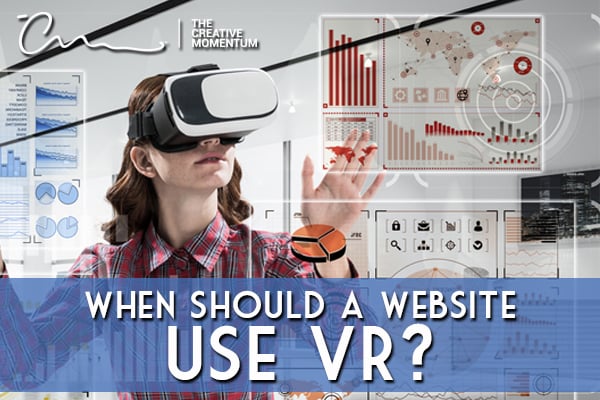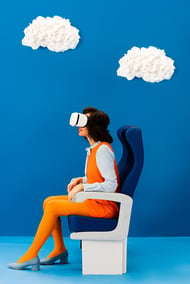
In the past few years, virtual reality (VR) has taken off. In 2018, the VR market was worth almost $8 billion. By 2024, experts estimate that it will grow to an astounding $44.7 billion, and the technology is still in its infancy! There’s no doubt that VR will have significant applications in the future.
Some brands are starting to integrate VR technology into their web design to give users a more immersive and engaging experience. Of course, VR isn’t suitable for every website, so what makes a website a good candidate for VR technology?
When Should a Website Use VR?
Virtual reality creates an immersive, interactive experience for users. To that end, a brand needs to offer something to interact with to be suitable for VR.
Here are two examples to illustrate:
- Yes, use VR. ✅ A hotel that offers a tangible item: a hotel room. They can use VR to let potential customers explore the space and get a feel for what it’s like to stay in their rooms.
- No, don't use VR. ❌ An accounting services firm. There’s no physical object for users to interact with. Such service firms would not benefit from using VR in their web design.
Brands that offers a tangible item that users can interact with are good candidates for using VR in their web design.
Current Website VR Applications
While VR is still in its infancy, brands are already using it to attract website visitors and allow them to interact with their products. Here are some of the most popular VR web design applications happening today:
Travel and Tourism

The travel and tourism industries are hitting VR hard. They’re using it to transport people to destinations all over the world, so they can experience what it’s like to be there. Once they see how beautiful it is, they’ll have no choice but to book a flight and a hotel room.
Navitaire was one of the first travel companies to utilize the power of VR. When you visit their site using VR technology, you’re shown a 3D, interactive image of the globe. Spin it around and click on any destination you want. Immediately, you’re transported to the destination of your choice.
Once you decide where you want to go, you can book a flight, hotel, and rental car straight from the VR interface. And you can check out the entire experience on their YouTube channel.
Real Estate Professionals
It’s nearly impossible to get a feel for the flow of a house from pictures alone. Touring a home is crucial for viewing the layout and transition between rooms. To make the process easier, real estate professionals use VR to transport potential buyers into the homes so they can see for themselves what it’s like to stand in the gourmet kitchen or how tall the ceilings really are.
Industry leaders like Zillow are creating detailed 3D models of homes to let potential buyers explore with VR technology. While you can’t virtually walk through the houses or interact with appliances (yet), this Google Maps-like layout will give you an idea of what it’s like to stand in your dream home without ever leaving the couch.
Retail Businesses
People are going to brick and mortar stores less frequently and shopping online more frequently, and the COVID-19 pandemic has exacerbated this trend with more people being stuck in their homes.
To overcome the lack of in-store visitors, some retailers are using VR to let customers interact with their products before they buy.
One of the best examples of retail VR web design is from Ikea. Ikea is using VR to let people see their products in a virtual environment, and it allows them to test the products. You can go to Ikea’s website and see what it’s like to cook meatballs using a specific stove from the comfort of your home. If only you could taste them when they’re finished.
Challenges of Using VR in Web Design
Just because you’re in an industry that can benefit from VR doesn’t mean that it’s right for you. VR is still a developing technology and there are plenty of challenges you’ll need to overcome if you want to implement it in your web design.
Not Everyone Has Access to VR Equipment
Yes, VR is a great way to let people virtually interact with your products, but only if they have a VR headset. While the numbers are growing, estimates show that 52.1 million people will use VR once a month in 2020. That might seem like a lot, but it’s only 15.7% of the total U.S. population. This means that 84.3% of people won’t experience your great VR content.
Virtual reality is geared toward a specific demographic. Before you implement it in your web design strategy, be sure you’re targeting the right audience to make it worthwhile.
Loading Times
If you thought videos slowed down your website loading times, try virtual reality. Research shows that 40% of website visitors will leave a site if it takes longer than three seconds to load. VR environments use massive amounts of data, and loading an entire virtual world can take a long time—well over three seconds.
If you plan to use VR in your web design, be sure that your content is either interesting enough that people will stick around for it or that you have a dedicated fan base. Otherwise, the loading times might scare your visitors away.
Production Requirements
Building a VR environment isn’t like creating a website. You can’t just head over to your favorite website builder, drag and drop a few blocks, and press the “publish” button. Creating virtual worlds takes time, specialized equipment, and expertise—three things not every company has access to. The intense production requirements make VR an expensive web design option.
Is VR Right for Your Website?
To be suitable for VR, your website needs to promote a tangible object or experience, have the right audience demographics to make it worthwhile, and the resources to create and implement virtual environments. If you meet all the criteria, VR could definitely help you create a more engaging and interactive website experience for your visitors.
If VR isn’t right for your website now, don’t rule it out completely. VR is still young, and the digital marketing landscape is always changing. New breakthroughs will certainly make virtual reality accessible to more brands across a broader range of applications in the future.


